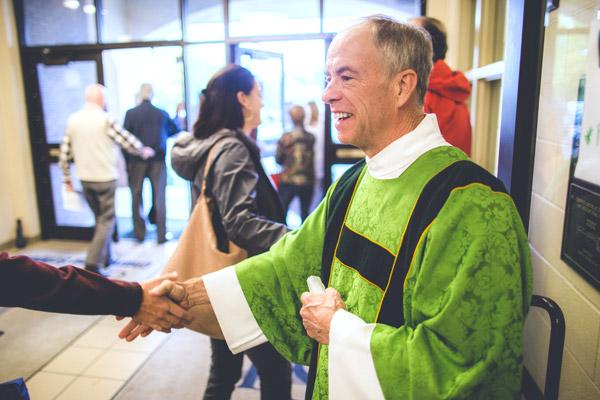
WASHINGTON — Since the permanent diaconate was re-established in the Catholic Church 50 years ago — the Church uses the term “restored” — the number of permanent deacons in the United States are now roughly half the number of priests.
Where would the Church be without these deacons?
“That’s a very good question,” replied Mary Gautier, a senior research associate at the Center for Applied Research in the Apostolate.
Gautier is the co-author of a new book published this year by CARA, “Word, Liturgy, Charity: The Diaconate in the U.S. Catholic Church, 1968-2018,” which examines how the diaconate has played itself out in the life of the Church over the past half-century. “Not that they replace priests, but they certainly complement one another,” she said.
The idea of the permanent diaconate “took off really well in the United States. It was a raging success here,” Gautier added.
In 1968 the U.S. bishops petitioned the Vatican for permission to restore the diaconate in this country. The Second Vatican Council called for the return of a permanent diaconate in the Latin Church, and Blessed Paul VI restored it in 1967. Although the Eastern Catholic churches kept the permanent diaconate, for hundreds of years the Latin church used the diaconate only as a transitional stage to the priesthood.
As of 2017, there were 18,287 permanent deacons in the U.S., compared to 37,181 ordained priests. About 40 percent of all permanent deacons worldwide are in the United States.
Once deacons are in, they’re in pretty much for good.
“There is some attrition, but it’s very, very small,” Gautier told Catholic News Service. “Some of it may have to do with the fact that deacons can’t even be ordained until they’re 35 — married deacons, anyway. They come in as married men. They’ve already sort of figured things out. They’re very stable.”
She added, “Every U.S. diocese has deacons. Almost every U.S. diocese has an active diaconate program. Even the ones that had been holding out have deacons now,” as deacons have moved to different dioceses from dioceses that had formation programs. “Even in the Eastern churches, where a priest can marry, there’s still deacons.”
“Deacons are ordained for ‘menial’ work that no one else wants to do: prison ministry, visiting the sick, hospital ministry, sacramental training,” said Deacon Tom Dubois of the Diocese of Toledo, Ohio, executive director of the National Association of Diaconate Directors. And, he laughed, “I’ve done all of them” since being ordained a deacon 18 years ago.
And it’s all done pretty much for free. “By design, the deacon is not on a stipend. We don’t get paid for doing our ministry. We don’t get anything,” Deacon Dubois said. “In my own case, the Toledo Diocese, we have some money set aside for retreats and continuing education — the same for priests.”
Deacons are expected to work in the everyday world. And they do.
Dubois said he had thought about the priesthood when he was a young teen, but decided it was not for him. “I had the thought years later when I entered deacon formation. I really put it together. I was being called to the diaconate, but when I was being called, the diaconate hadn’t been restored yet.”
Deacon Ray Duplechain, director of the diaconate program in the Archdiocese of New Orleans, has been a deacon for 22 years. He said he was looking forward to the National Diaconate Congress later in July in his native New Orleans: “There is still quite a bit of interest in it (the diaconate). When people see what deacons do, and discern, we feel there are still plenty more out there who are being called. It’s not waning.”
One sticking point for deacons can be how priests regard them and their ministry, and the assignments given them by a priest.
“Bishop (W.) Sean McKnight (of Jefferson City, Mo.), when he was doing his doctorate, studied the diaconate,” Dubois said. “He just released a book about the diaconate.” He added the deacon serves, in essence, as an “emissary for the bishop. The deacon becomes the bishop’s man to do something the bishop wants done. If you think in those terms,” he added, “it really opens up the possibilities.”
Please read our Comments Policy before posting.
Article comments powered by Disqus Sixty men seeking to be deacons begin their formation
Sixty men seeking to be deacons begin their formation
 Brother Raban ordained deacon, preparing for priesthood
Brother Raban ordained deacon, preparing for priesthood
 Eveld: ‘Knowing the Lord called me is an awesome thing’
Eveld: ‘Knowing the Lord called me is an awesome thing’
 63 hombres elegidos para clase de formación diaconal
63 hombres elegidos para clase de formación diaconal
 63 men chosen for next diaconate formation class
63 men chosen for next diaconate formation class
 Winning directory photo honors Our Lady of Guadalupe
Winning directory photo honors Our Lady of Guadalupe
 St. Paul says: How does the Bible define love?
St. Paul says: How does the Bible define love?
 6 steps to getting married in Diocese of Little Rock
6 steps to getting married in Diocese of Little Rock
 Most frequently asked questions on Catholic marriage
Most frequently asked questions on Catholic marriage
 St. Joseph a model of solidarity with immigrants
St. Joseph a model of solidarity with immigrants
 Two gifts after Jesus’ death: Virgin Mary and Eucharist
Two gifts after Jesus’ death: Virgin Mary and Eucharist
 Why we have an altar, and not just a communion table
Why we have an altar, and not just a communion table
 Pope: Wars should be resolved through nonviolence
Pope: Wars should be resolved through nonviolence
 Living relationship with Jesus Christ in the Eucharist
Living relationship with Jesus Christ in the Eucharist